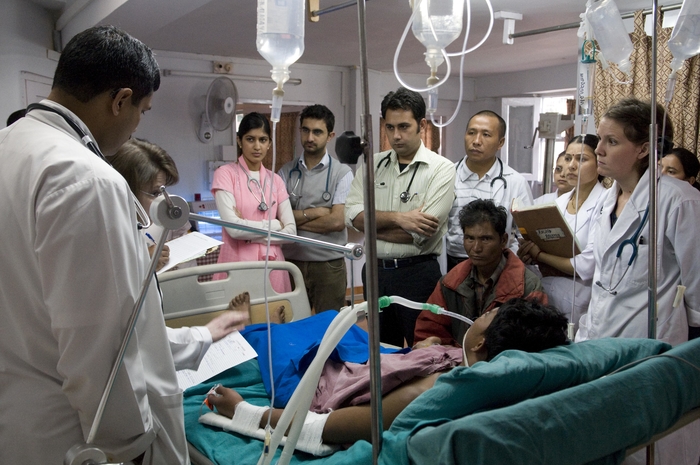
How a poor allocation of budget on healthcare can put the blame on you, the doctor
The frequent call of ‘negligence!’ and the subsequent assaults on doctors in India have one overwhelming reason- the public’s perception of the medical field. Unless they are aware of the constraints under which the doctors do their job in the country, the scenario will largely remain unchanged.
And one of the main causes for the constraints is the lower allocation of allocation of money on healthcare in India.
But before we get into the deeper picture which is bleak, first, some good news:
The first decade of the 21st century saw some great things happening in the public health in the country- thanks to concerted efforts by policy makers and doctors. We’re talking about such things as an amazing decline in infant and maternal mortality rates, complete eradication of poliomyelitis and neonatal tetanus.
The point to note here is that these achievements wouldn’t have been possible without higher investments in public health.
The rise in allocations in the past decade
- The budget allocations for the health sector has increased each year since 2005
- The allocation rose by 300% between 2005 and 2010
- A rise from Rs.10,000 crores to Rs,30,000 crores.
- The graduation is from 0.9% of total GDP to 1.3%.
The bulk of the allocations was to benefit the National Rural Health Mission which sought to improve medical infrastructure in those states that are lesser developed in the country. And advances were definitely made in those states.
Now, the bad news:
Amidst the advances we have made, certain facts shouldn’t be forgotten. Like these:
- How 4000 to 5000 community health centres still don’t have even a single obstetrician
- The positions of around 15,000 doctors which are vacant in primary health centres.
- The 1.3% of GDP which we have allocated for the health sector also makes India among the countries with the lowest relative public expenditure for health.
- Even Nepal, which falls behind Nepal on many indicators have a higher spend on health.
Public expenditure on health was to be raised to 2.5% of GDP as per the Twelfth Five Year Plan and the draft health policy 2015. This would be possible only with 30 to 40 percent in the Union health budget every single year. Also, it would also demand higher allocations in the state budgets. The reality is that the Rs.33,000 Crores allocation is just a minor rise in health allocation of 13% compared to last year’s. This is actually lesser the allocation in the year before that.
In other words, the Finance ministry rarely allocates enough funds to meet the government’s commitment.
The not-nearly-enough target of 2.5%
The target of 2.5% of the total GDP in itself is not nearly enough-if we are to stand alongside the others in the BRICS in healthcare-which is something that India aspires to. For one thing, those countries have a GDP percentage spend on health ranging from 3.5% to 8.5%.
The bottomline is that if we are to have a better health care system in India, we need higher allocations.
More dialysis centers but no investment for more prevalent diseases like TB
End stage renal disease is not among the top ten reasons of adult deaths in India. Neither was it identified as a priority in the National Health Policy of 2002 or 2015. But the recent budget had the announcement that dialysis centres will be opened in district hospitals across India. This, while there exists no evidence that adding dialysis centres in district hospitals will help address the condition. Also when diseases that contribute significantly to adult mortality-for instance, TB exists in the country.
How a lack of cheaper drugs could be remedied
Rajastan and Tamil Nadu are two states that serve as excellent examples of the government making generic drugs available through government-run primary health centres. The idea has resulted in higher savings as well as helping lower income families access drugs on cheaper rates. Rather that endorsing such a practice, the recent Union budget saw the proposal of starting 3,000 government-run pharmacies to increase access to cheaper medicine.
There are an estimated 8,50,000 pharmacies in the country that sell branded drugs at higher prices. The 3,000 outlets that the budget has proposed will make up just 1% of the total number of pharmacies in the nation. The extent to which this relatively small number can help people access cost-effective medicine will be negligible, to say the least.
The renewed health insurance scheme that doesn’t quite work
The health insurance scheme that the finance minister announced for the sake of the poor modifies on the current Rashtriya Swasthya Bima Yojana(RSBY). The new scheme is called Rashtriya Swasthya Suraksha Yojana. The annual limit for a family has been increased from Rs. 30,000 to Rs. 1,00,000. Also, an additional raise of Rs.30,000 has been allotted for senior citizens.
All good and well but here’s the flipside-Even with the lower reimbursements, it’s estimated that it will take Rs.2,460 Cr. to Rs.3,350 Cr. if we are to enrol the Below Poverty Line families in India. Now that the reimbursement limit has been hiked to Rs.1,00,000 the required budgetary allocations will be way higher. The Rs. 1,500 Crore which the budget presently allows is not nearly enough.
While these and other flaws in the allocation of budget for healthcare would definitely affect the public negatively, doctors too could suffer because of it. It is safe to assume that a large chunk of the population may not know about these flaws for various reasons-ranging from illiteracy to simply not having the time. But for anyone who seeks medical help, the doctor is almost always the point of contact. The imperfect healthcare system that we have will result in poorer treatment results or fatalities, as been always the case.
But sometimes it’s the doctor who will take most of the blames, and the assaults.
Image credits: manalihospitals.com
Images may be indicative